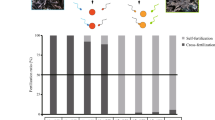Abstract.
Synchronous spawning of many coral species that co-occur on Indo-Pacific reefs raises the possibility that hybridization plays a role in their evolution. Here we use experimental crosses to examine mating compatibilities and breeding barriers in a group of sessile animals whose mating systems are primarily governed by interactions among free-spawned gametes. We found hybridization occurs readily in more than one-third of 42 species pairs from the common genera Acropora, Montipora and Platygyra. Mean fertilization success ranged from 1% to 50% in species crosses, but standard deviations about these means were large and in some cases, fertilization success in individual colony matings was greater than 95%. Cases of high fertility in individual, interspecific matings were found in all three genera. Hybridization occurred most readily between species that were morphologically similar, identifying areas where current taxonomic judgements may require further testing. However, cases of significant hybridization also occurred between species that are morphologically distinct. Evidence of in vitro hybridization combined with the lack of either temporal or spatial barriers to interbreeding among field populations of these species, indicates that natural hybridization may occur commonly between congeneric corals that are currently recognized as distinct species. We also detected mating incompatibilities between some colonies within some species. In some cases, incompatible colonies corresponded to distinct morphotypes, but not in others. Thus some breeding groups in scleractinian corals are potentially larger, but others are smaller, than would be predicted using morphological criteria. Gamete incompatibilities within a morphospecies that readily hybridizes with other species may be the result of a mating system that is governed by gamete-level interactions. Imprecision in the alignment of morphological and breeding boundaries suggests a single species concept may not apply to scleractinian corals and challenges the tacit assumption that currently defined coral species encompass biological, evolutionary and phylogenetic species. Hybridization between supposedly isolated species introduces a reticulate nature to the evolution of corals and has profound implications for present understanding of the population genetics, phylogenetics, and evolutionary biology of scleractinian corals.
Similar content being viewed by others
Author information
Authors and Affiliations
Additional information
Accepted: 20 January 1997
Rights and permissions
About this article
Cite this article
Willis, B., Babcock, R., Harrison, P. et al. Experimental hybridization and breeding incompatibilities within the mating systems of mass spawning reef corals. Coral Reefs 16 (Suppl 1), S53–S65 (1997). https://doi.org/10.1007/s003380050242
Issue Date:
DOI: https://doi.org/10.1007/s003380050242




